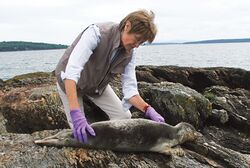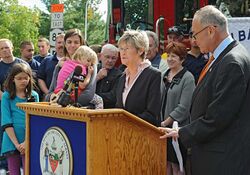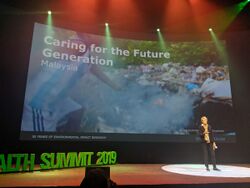Biography:Susan D. Shaw
Susan D. Shaw | |
|---|---|
 | |
| Born | October 24, 1943 Dallas, Texas, United States |
| Nationality | United States |
| Alma mater | Columbia University School of Public Health University of Texas at Austin |
| Awards | Society of Woman Geographers’ Gold Medal Award, Explorers Club Citation of Merit, Gulf of Maine Visionary Award |
| Scientific career | |
| Fields | Environmental Health, Toxicology |
| Institutions | University at Albany, SUNY |
| Website | www.shawinstitute.org |
Susan D. Shaw (born October 24, 1943 in Dallas, Texas) is an American environmental health scientist, explorer, ocean conservationist, and author. A Doctor of Public Health, she is a professor in the Department of Environmental Health Sciences at the School of Public Health at the State University of New York at Albany, and Founder/President of the Shaw Institute, a nonprofit scientific institution with a mission to improve human and ecological health through innovative science and strategic partnerships. Shaw is globally recognized for pioneering high-impact environmental research on ocean pollution, climate change, oil spills, and plastics that has fueled public policy over three decades. In 1983, with landscape photographer Ansel Adams, she published Overexposure, the first book to document the health hazards of photographic chemicals.[1][2] Shaw is credited as the first scientist to show that brominated flame retardant chemicals used in consumer products have contaminated marine mammals and commercially important fish stocks in the northwest Atlantic Ocean.[3][4] She became the first scientist to dive into the Gulf of Mexico oil slick following the 2010 BP Deepwater Horizon oil rig explosion to investigate the impacts of chemical dispersants used in response to the spill.[5][6][7][8]
Recognized as an outspoken voice on emerging contaminants like plastic,[9] Shaw travels globally to raise awareness on toxic legacy of man-made chemicals and its impact on public health and the environment.[10] An expert in occupational exposure to burning plastic and cancer in firefighters, Shaw was named US Science Liaison to the international Plastic Health Coalition in 2019.
Education and early career
Shaw received a Bachelor of Arts degree from the University of Texas in 1967 with a major in Plan II, an interdisciplinary honors program modeled after the Harvard Society of Fellows Program.[11] Selected for the UT-Chilean Exchange Program in 1964, she spent a year in Chile as a Fulbright Scholar. She earned an MFA degree in Film from Columbia University in 1970, and a doctorate in Public Health/Environmental Health Sciences (Dr.P.H.) from Columbia University's School of Public Health in 1999.
In 1980, Ansel Adams commissioned her to write Overexposure, published in 1983 as the first book to document the health hazards of photographic chemicals used in the darkroom.[2] A second edition of the book was published in 1991.[12]
Shaw founded the Shaw Institute in Blue Hill, Maine in 1990 following the deaths of 20,000 harbor seals inhabiting polluted waters of northwestern Europe.[13] This wildlife “signal” event was followed by other mass die-offs of marine mammals in polluted marine regions.[14][15] Advancing understanding of the impacts of toxic chemicals on marine mammal health became the Institute's research focus over the next two decades.[16] The Institute's mission is to protect the environment and people from the effects of harmful exposure in three priority areas: halogenated flame retardants and other persistent organic pollutants (POPs), chemical dispersants used in oil spills, and plastic pollution.
Research
For three decades, Shaw's work has focused on the health effects of environmental chemical exposure in marine wildlife and humans.
In 2000, the Shaw Institute began its long-term research focused on marine sentinel species to characterize the extent of contamination of the northwest Atlantic marine ecosystem from Maine to New York.[17][18] Funded by the National Oceanic and Atmospheric Administration (NOAA), this region-wide effort has produced a large body of data on a wide range of persistent organic pollutants, including flame retardants, in marine mammals and fish that has placed the region in a global perspective.[19] This work has shown that levels of toxic chemicals, such as polychlorinated biphenyls (PCBs), in northwest Atlantic harbor seals are among the highest in the world.[20][21]
In 2007, Shaw was credited as the first scientist to show that brominated flame retardant chemicals used in household and consumer products have contaminated marine mammals and fish in the northwest Atlantic Ocean.[22][23][24] This information helped support toxics policy reform in the state of Maine when the Legislature banned Deca-BDE from household products as of 2010.[25][26]
That same year, Shaw was lead author on a review paper on halogenated flame retardants, titled Halogenated Flame Retardants: Do the Fire Safety Benefits Justify the Risks?, which challenged the efficacy of these chemicals in preventing fire deaths. It presented a large body of scientific evidence of the negative health effects, including cancer, that are associated with exposure to halogenated flame retardants in consumer products.[27]
The paper had national policy implications, laying the groundwork for the San Antonio Statement, which cited the need for regulatory action on halogenated flame retardant chemicals worldwide.[28] It was signed by more than 300 scientists from 30 countries.[29] Shaw's paper and the statement were, in turn, the basis for the Chicago Tribune’s 2012 exposé of the chemical industry’s campaign to market harmful flame retardant chemicals to the American public.[30]
BP Oil Spill
In May 2010, a month after the explosion of the Deepwater Horizon oil rig in the Gulf of Mexico, Shaw dove into the oil slick to investigate the impact of the chemical dispersant Corexit, which was being used to contain the oil spill. Her findings informed the national debate on the dangers of chemical dispersant use.[31] She maintained that the dispersant-oil mixture was more toxic to wildlife and human health than the oil alone, because of the increased exposure to hydrocarbons in the water column, and the synergistic toxicity of Corexit and oil components combined.[6][7][32][33]
Shaw was appointed to the Strategic Sciences Working Group (SSWG), convened by the US Department of the Interior, to assess the consequences of the oil spill and make policy recommendations to federal agencies.[34] In September 2010, she drafted a scientific memo titled “It’s Not About Dose” on behalf of the SSWG stating there is no safe level of exposure to cancer-causing hydrocarbons in oil.[35] The memo warned that the use of Corexit dispersants, in combination with crude oil, would result in long-term damage to wildlife and human health in the Gulf region.[36] The Shaw Institute subsequently launched Gulf EcoTox, an independent investigation into the effects of oil and chemical dispersants in the food web.[37]
Shaw predicted the decimation of deep-water coral, species known to be sensitive to the Corexit-oil mixture, and the deaths of dolphins from unavoidable inhalation of the mixture as they surfaced to breathe.[5][38] Both outcomes have since occurred.[39][40] She also predicted with certainty the human health crisis in the Gulf today, stating that a scientific review found that “five of the Corexit ingredients are linked to cancer, 33 are associated with skin irritation from rashes to burns, 33 are linked to eye irritation, 11 are or are suspected of being potential respiratory toxins or irritants, and 10 are suspected kidney toxins.”[41][42]
She delivered three TEDx talks discussing the long-term damage to the ecosystem and the impending human health crisis in the Gulf as a result of exposure to the oil-Corexit mixture.[36][43][44] She appeared in documentary films on the oil spill, including Animal Planet’s Black Tide: Voices of the Gulf and Green Planet's The Big Fix.[1]
Current work
The Shaw Institute's research examines the sources, fate, exposure pathways, tissue-specific bioaccumulation/biomagnification, and health effects of organic halogenated chemicals and other toxic man-made chemicals in the environment. The organization's current work focuses on highly exposed populations, including firefighters, to indoor contaminants including flame retardants and carcinogenic combustion by-products that may relate to their elevated rates of cancer.[45][46] An expert on marine pollution, Shaw currently leads a multinational project with scientists from Sweden, Greenland and Iceland to assess the converging impacts of climate change and flame retardant chemicals on marine mammals from the US Atlantic, Baltic, and Arctic seas.
In 2013, Shaw was lead investigator of a study that tested a group of firefighters in San Francisco [47] and found that their blood contains high levels of flame retardants and cancer-causing chemicals such as dioxins and furans, produced by the burning of flame-retarded household materials.[48] The study's findings suggested that chemical exposure during firefighting may carry higher risk for multiple cancers than previously demonstrated.[49] Based on these findings, in 2014, the Institute announced plans for a long-term study of chemical exposure and cancer risk in U.S. firefighters.[50]
In 2012 Shaw launched a study into microplastics in the Gulf of Maine that influenced a nationwide ban of microbeads in cosmetics. Shaw Institute scientists lead a 2018 study on the uptake and expulsion of microplastic fibers by blue mussels (Mytilus edulis) in the Gulf of Maine.[51] In 2018, Shaw Institute partnered with the international Plastics Health Coalition in order to advance understanding of the damaging effects of microplastics in the human body and to promote plastic reduction across multiple sectors on a global scale.
Honors and awards
Shaw is a Woodrow Wilson Visiting Fellow to U.S. universities[52] and was named a Gulf of Maine Visionary by the Gulf of Maine Council on the Marine Environment in 2007[53] In May 2011, she received the Society of Woman Geographers’ Gold Medal Award.[54][55] In March 2012, Shaw received the Explorers Club Citation of Merit Award for her work in ocean conservation.[31] In 2011, she was named “Woman of the Gulf” by Audubon Society Women in Conservation at the Rachel Carson Awards. She was a recipient of the 2012 Next Award from Mainebiz magazine for her work in shaping the future and the economy of Maine.[56] On Earth Day 2019, Shaw was named one of the "Top Eco-Warrior Women in the World" by Make it Better magazine.[57]
References
- ↑ 1.0 1.1 Cassie, Ron (2012-04-08). "Diving deep: Susan Shaw, ocean crusader and environmental health pioneer". http://grist.org/pollution/diving-deep-susan-shaw-ocean-crusader-and-environmental-health-pioneer/.
- ↑ 2.0 2.1 Shaw, Susan (1983). Overexposure: Health Hazards in Photography. Friends of Photography. ISBN 978-0933286375.
- ↑ "Speakers: Susan Shaw: Marine toxicologist". http://www.ted.com/speakers/susan_shaw.html.
- ↑ Shaw, Susan D.; Berger, Michelle L.; Brenner, Diane; Kannan, Kurunthachalam; Lohmann, Nina; Päpke, Olaf (May 2009). "Bioaccumulation of polybrominated diphenyl ethers and hexabromocyclododecane in the northwest Atlantic marine food web". Science of the Total Environment 407 (10): 3323–3329. doi:10.1016/j.scitotenv.2009.02.018. PMID 19269019. Bibcode: 2009ScTEn.407.3323S.
- ↑ 5.0 5.1 Gertz, Emily. "Marine Toxicologist Susan Shaw Dives Into Gulf Spill, Talks Dispersants and Food Web Damage". OnEarth. http://www.onearth.org/blog/marine-toxicologist-susan-shaw-dives-into-gulf-spill-talks-dispersants-and-food-web-dam.
- ↑ 6.0 6.1 Schor, Elana (July 30, 2010). "Oil Spill Dispersants Shifting Ecosystem Impacts in Gulf, Scientists Warn". New York Times. https://www.nytimes.com/gwire/2010/07/30/30greenwire-oil-spill-dispersants-shifting-ecosystem-impac-95608.html.
- ↑ 7.0 7.1 Shaw, Susan D.. "Consensus Statement: Scientists oppose the use of dispersant chemicals in the Gulf of Mexico". http://meriresearch.org/Portals/0/Documents/CONSENSUS%20STATEMENT%20ON%20DISPERSANTS%20IN%20THE%20GULF%20updated%20July%2017.pdf.
- ↑ Shaw, Susan D. (2010-05-29). "Swimming Through the Spill". The New York Times. https://www.nytimes.com/2010/05/30/opinion/30shaw.html.
- ↑ TEDx Talks, Science, Lies, and Politics | Susan Shaw | TEDxMidAtlantic, https://www.youtube.com/watch?v=9DdEo-RXI5c, retrieved 2019-01-24
- ↑ (in en) Susan Shaw on the hidden danger of plastic in a world on fire | Plastic Health Summit 2019, https://www.youtube.com/watch?v=DktdVr3MTic, retrieved 2020-02-05
- ↑ "Plan II Honors Program Description". http://www.utexas.edu/cola/progs/plan2/about/.
- ↑ Shaw, Susan D.; Monona Rossol (1991). Overexposure: Health Hazards in Photography (2 ed.). United States: Skyhorse Publishing. ISBN 978-0960711864. https://archive.org/details/overexposureheal00shaw.
- ↑ Rivlin, Michael A. (Fall 2001). "Northern Exposure". OnEarth Magazine. http://www.nrdc.org/onearth/01fal/seals.asp.
- ↑ Shaw, Susan (September 24, 1991). "Marine life under siege". Los Angeles Times. http://www.meriresearch.org/Portals/0/Images/PDFs/Marine%20life%20under%20siege.pdf.
- ↑ Raloff, Janet (July 2, 1994). "Something's Fishy". Science News. http://www.meriresearch.org/Portals/0/7-2-1994ScienceNewsSomethingsFishy.pdf.
- ↑ Quimby, Beth (May 15, 2011). "Adventurous scientist to receive national honors". Portland Press Herald. http://www.pressherald.com/news/adventurous-scientist-to-receive-national-honors_2011-05-15.html?pagenum=full.
- ↑ Casco Bay Estuary Partnership (2007). "How are seals, as top predators, impacted by toxic contaminants in Casco Bay and the Gulf of Maine?". Toxic Pollution in Casco Bay: Sources and Impacts.
- ↑ Gertz, Emily (February 26, 2013). "Tackling a Hidden Threat to Marine Mammals". Ensia. http://ensia.com/articles/tackling-a-hidden-threat-to-marine-mammals/.
- ↑ Shaw, Susan D.; Kurunthachalam Kannan (July–September 2009). "Polybrominated diphenyl ethers in marine ecosystems of the American continents: foresight from current knowledge". Reviews on Environmental Health 24 (3): 157–229. doi:10.1515/REVEH.2009.24.3.157. PMID 19891120.
- ↑ Mack, Sharon Kiley (September 8, 2011). "More man-made contaminants discovered in Maine's harbor seals". Bangor Daily News. http://bangordailynews.com/2011/09/08/news/down-east/more-man-made-contaminants-discovered-in-maine’s-harbor-seals/?ref=search.
- ↑ Shaw, Susan D.; Michelle L. Berger; Liesbeth Weijs; Olaf Päpke and Adrian Covaci (August 15, 2014). "Polychlorinated biphenyls still pose significant health risks to northwest Atlantic harbor seals". Science of the Total Environment 490: 477–487. doi:10.1016/j.scitotenv.2014.05.011. PMID 24875260. Bibcode: 2014ScTEn.490..477S.
- ↑ Fraser, Doug (October 15, 2007). "Mysterious seal deaths linked to chems". Cape Cod Times. http://www.capecodonline.com/apps/pbcs.dll/article?AID=/20071015/NEWS/710150327.
- ↑ Shaw, Susan D.; Michelle L. Berger; Diane Brenner; David O. Carpenter; Lin Tao; Chia-Swee Hong; Kurunthachalam Kannan (April 2008). "Polybrominated diphenyl ethers (PBDEs) in farmed and wild salmon marketed in the Northeastern United States". Chemosphere 71 (8): 1422–1431. doi:10.1016/j.chemosphere.2008.01.030. PMID 18313722. Bibcode: 2008Chmsp..71.1422S.
- ↑ Shaw, Susan D.; Diane Brenner; Michelle L. Berger; Fu Fang; Chia-Swee Hong; Rudolf Addink; David Hilker (December 2008). "Bioaccumulation of polybrominated diphenyl ethers in harbor seals from the northwest Atlantic". Chemosphere 73 (11): 1773–1780. doi:10.1016/j.chemosphere.2008.09.016. PMID 18950831. Bibcode: 2008Chmsp..73.1773S.
- ↑ Mack, Sharon Kiley (September 8, 2011). "More man-made contaminants discovered in Maine's harbor seals". http://bangordailynews.com/2011/09/08/news/down-east/more-man-made-contaminants-discovered-in-maine’s-harbor-seals/?ref=search.
- ↑ "An Act to Clarify Maine's Phaseout of Polybrominated Diphenyl Ethers". 124th Maine State Legislature. http://www.mainelegislature.org/legis/bills/bills_124th/chappdfs/PUBLIC610.pdf.
- ↑ Shaw, Susan D.; Arlene Blum; Roland Weber; Kurunthachalam Kannan; David Rich; Donald Lucas; Catherine P. Koshland; Dina Dobraca et al. (Oct–Dec 2010). "Halogenated flame retardants: do the fire safety benefits justify the risks?". Reviews on Environmental Health 25 (4): 261–305. doi:10.1515/REVEH.2010.25.4.261. PMID 21268442.
- ↑ DiGangi, Joseph; Arlene Blum; Åke Bergman; Cynthia A. de Wit; Donald Lucas; David Mortimer; Arnold Schecter; Martin Scheringer et al. (December 2010). "San Antonio Statement on Brominated and Chlorinated Flame Retardants". Environmental Health Perspectives 118 (12): A516–A518. doi:10.1289/ehp.1003089. PMID 21123135.
- ↑ Walsh, Bryan (October 28, 2010). "Flame Retardants in Everyday Products May Be a Health Hazard, Scientists Say". Time Magazine. http://healthland.time.com/2010/10/28/chemical-safety-scientists-come-out-against-chemical-flame-retardants-in-ordinary-products/.
- ↑ "Tribune watchdog: Playing with fire". Chicago Tribune. http://media.apps.chicagotribune.com/flames/index.html.
- ↑ 31.0 31.1 Leibach, Julie (April 20, 2012). "Is the Gulf Getting Better? A Marine Toxicologist Weighs In". Audubon Magazine. http://www.audubonmagazine.org/articles/conservation/marine-toxicologist-weighs-health-gulf.
- ↑ Levitt, Tom; Nicole Edmison (September 6, 2010). "Toxic dispersants in Gulf oil spill creating hidden marine crisis". The Ecologist. http://www.theecologist.org/News/news_analysis/583740/toxic_dispersants_in_gulf_oil_spill_creating_hidden_marine_crisis.html.
- ↑ "Dr. Susan Shaw measures the BP oil disaster's long-term impact". WGBH - Greater Boston. http://www.wgbh.org/includes/playerPop.cfm?featureid=37356.
- ↑ "DOI Strategic Sciences Working Group". http://www.strategicsciencesworkinggroup.com/omeka-1.2.1/archive/files/press-packet-final_91bb6aa0af.pdf.
- ↑ Shaw, Susan D.. "Science Insight: It's Not About Dose". http://www.meriresearch.org/Portals/0/ScienceInsightforweb.pdf.
- ↑ 36.0 36.1 Sherwood, Christina Hernandez (March 21, 2012). "Q&A: Susan Shaw, marine toxicologist". SmartPlanet. http://www.smartplanet.com/blog/pure-genius/q-a-susan-shaw-marine-toxicologist/7897?tag=content;siu-container.
- ↑ Hewitt, Rich (April 13, 2011). "Deep Water Horizon oil still affects Gulf Coast environment, residents". Bangor Daily News. http://bangordailynews.com/2011/04/13/news/hancock/deep-water-horizon-oil-still-affects-gulf-coast-environment-residents/.
- ↑ "The Oil Spill's Toxic Trade-off". Huffington Post. July 27, 2010. http://www.huffingtonpost.com/tedtalks/susan-shaw-the-oil-spills_b_660792.html.
- ↑ Gerken, James (March 26, 2012). "Gulf Oil Spill: Coral Death 'Definitively' Linked To BP Spill". AP/Huffington Post. http://www.huffingtonpost.com/2012/03/26/gulf-oil-spill-coral-death_n_1380712.html?ref=green&ncid=edlinkusaolp00000009.
- ↑ McConnaughey, Janet (April 2, 2013). "Gulf Of Mexico Dolphin Deaths Point To Continued Effects Of BP Oil Spill, Group Alleges". AP/Huffington Post. http://www.huffingtonpost.com/2013/04/02/gulf-of-mexico-dolphin-deaths-bp_n_3001408.html.
- ↑ Jamail, Dahr (October 27, 2013). "BP's 'widespread human health crisis'". Al Jazeera. http://www.aljazeera.com/indepth/features/2013/10/bp-widespread-human-health-crisis-2013102717831227732.html.
- ↑ The Chaos of Clean-Up (Report). August 2011. http://earthjustice.org/sites/default/files/Oil_Dispersants_Report.pdf.
- ↑ "TEDxMidAtlantic 2010 - Susan Shaw - Six Months After Oil Spill, Where Are We?". TED. http://tedxtalks.ted.com/video/TEDxMidAtlantic-2010-Susan-Sh-2.
- ↑ "Reckless Endangerment: The Gulf Oil Spill Revisited". https://www.youtube.com/watch?v=72sCg-X0zE4.
- ↑ Taking Action Against Cancer in the Fire Service. Firefighter Cancer Support Network. August 2013. http://www.firefightercancersupport.org/wp-content/uploads/2013/08/Taking-Action-against-Cancer-in-the-Fire-Service.pdf.
- ↑ Daniels, Robert D.; Travis L. Kubale; James H. Yiin (October 14, 2013). "Mortality and cancer incidence in a pooled cohort of US firefighters from San Francisco, Chicago and Philadelphia (1950− 2009)". Occup Environ Med 71 (6): 388–397. doi:10.1136/oemed-2013-101662. PMID 24142974.
- ↑ Shaw, Susan D.; Michelle L. Berger; Jennifer H. Harris; Se Hun Yun; Qian Wu; Chunyang Liao; Arlene Blum; Anthony Stefani et al. (8 February 2013). "Persistent organic pollutants including polychlorinated and polybrominated dibenzo-p-dioxins and dibenzofurans in firefighters from Northern California". Chemosphere 91 (10): 1386–94. doi:10.1016/j.chemosphere.2012.12.070. PMID 23395527. Bibcode: 2013Chmsp..91.1386S.
- ↑ Thorsen, Nina (February 22, 2013). "Flame Retardants Pose Special Risk to Firefighters". KQED News. http://www.kqed.org/news/story/2013/02/22/116783/flame_retardants_pose_special_risk_to_firefighters?category=health.
- ↑ Shaw, Susan D. (March 6, 2013). "A burning issue for firefighters: Flame retardants and cancer". The Hill. http://thehill.com/blogs/congress-blog/healthcare/286589-a-burning-issue-for-firefighters-flame-retardants-and-cancer.
- ↑ Marshall, Dr. Malika (May 19, 2014). "Hidden Danger Putting Firefighters At Risk For Cancer". CBS Boston. http://boston.cbslocal.com/2014/05/19/hidden-danger-putting-firefighters-at-risk-for-cancer.
- ↑ "How mussels handle microplastic fiber pollution: Results have implications for how ubiquitous plastic pollution moves through food webs" (in en). https://www.sciencedaily.com/releases/2018/12/181204131127.htm.
- ↑ "Woodrow Wilson Visiting Fellows - Susan Shaw". The Council of Independent Colleges. http://www.cic.edu/Programs-and-Services/Programs/Woodrow-Wilson-Visiting-Fellows/Pages/Susan-Shaw.aspx.
- ↑ Rappaport, Stephen (June 14, 2007). "MERI Founder and Director Susan Shaw Wins Gulf of Maine Visionary Award". Ellsworth American. http://www.meriresearch.org/Portals/0/Documents/EA%20Waterfront%20Visionary%20Award%20article%206%2014%2007.pdf.
- ↑ Hewitt, Rich (May 4, 2011). "Marine research institute director to receive national awards". Bangor Daily News. https://bangordailynews.com/2011/05/04/news/marine-research-institute-director-to-receive-national-awards/.
- ↑ Raloff, Janet (June 24, 2011). "Marine scientist joins ranks of Amelia Earhart, Jane Goodall". http://meriresearch.org/Portals/0/ScienceNewsProfile062411.pdf.
- ↑ Valigra, Lori (October 15, 2012). "Susan Shaw fights pollutants to keep Maine's coast open for business". Mainebiz. http://www.mainebiz.biz/article/20121015/CURRENTEDITION/310119990/susan-shaw-fights-pollutants-to-keep-maine's-coast-open-for-business.
- ↑ "How AOC and 6 Other Eco-Warriors Fight Climate Change and Encourage Sustainable Living" (in en-US). 2019-04-16. https://better.net/chicago/life/eco-warriors-share-sustainable-living-practices-actually-move-needle/.



